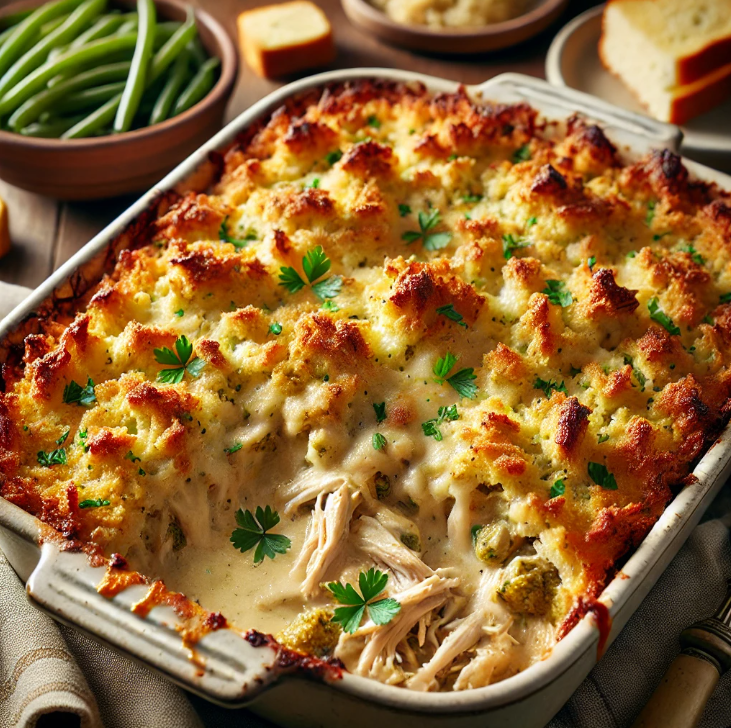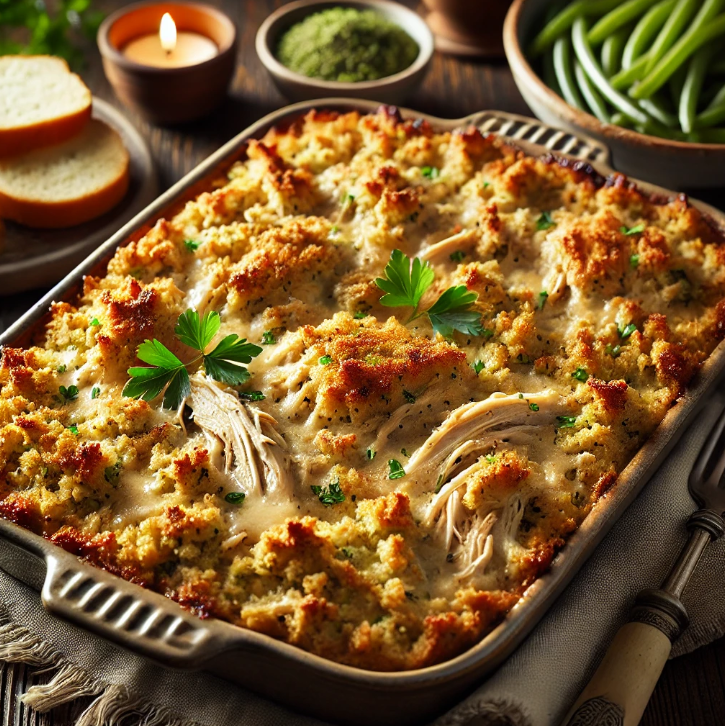When it comes to comfort food, few dishes can rival the warmth and heartiness of a Chicken and Dressing Casserole. This classic dish, with its tender chicken and savory dressing, is a staple at Southern tables, especially during the holidays. But it’s not just for special occasions—it’s a versatile recipe perfect for weeknight dinners or potluck gatherings.
In this guide, we’ll delve into everything you need to know about making the best Chicken and Dressing Casserole. From its origins and ingredients to step-by-step instructions and creative variations, you’ll find all the tips and tricks to master this comforting dish. Let’s dive in!
Table of Contents
What is Chicken and Dressing Casserole?
The Origins of Chicken and Dressing Casserole
Chicken and Dressing Casserole is deeply rooted in Southern culinary traditions, where it often takes center stage at family gatherings and holiday feasts. Dressing, a savory bread-based dish, evolved as a variation of stuffing, cooked separately rather than inside a bird. Combining it with tender chicken and rich broth creates a dish that’s both satisfying and flavorful.
This casserole became popular for its ability to feed a crowd using simple, accessible ingredients. Over time, it has been adapted in countless ways, showcasing its versatility and enduring appeal.
What Makes Chicken and Dressing Casserole Special?
The magic of a Chicken and Dressing Casserole lies in its perfect balance of textures and flavors. The dressing, often made with cornbread, is moist and savory, soaking up the flavors of the chicken and broth. Meanwhile, the chicken adds protein and a hearty bite, making this dish a complete, one-pan meal.
It’s a dish that offers both convenience and nostalgia. Whether you’re serving it fresh out of the oven or reheating leftovers the next day, its comforting flavors remain just as delicious. With endless ways to customize it, Chicken and Dressing Casserole truly stands out as a timeless comfort food.
Ingredients for Chicken and Dressing Casserole
Essential Ingredients for Authentic Flavor
A classic Chicken and Dressing Casserole is all about simple, flavorful ingredients that work together to create a hearty dish. Here’s what you’ll need:
- Chicken: Use cooked, shredded chicken for the best texture. Rotisserie chicken is a convenient option, but leftover baked or boiled chicken works just as well.
- Cornbread: Homemade or store-bought cornbread serves as the base for the dressing. Its slightly crumbly texture and mild sweetness perfectly complement the savory elements.
- Chicken Broth: This adds moisture and depth of flavor to the dressing. Opt for low-sodium broth to control the saltiness.
- Onions and Celery: These vegetables bring a subtle crunch and aromatic base that enhances the overall flavor.
- Butter: Melted butter helps to bind the dressing and adds richness to the dish.
- Eggs: Beaten eggs provide structure, helping the casserole hold its shape when baked.
- Herbs and Spices: A mix of sage, thyme, and black pepper creates that classic dressing flavor. You can adjust the seasoning to suit your taste.
Optional Add-Ins and Variations
To make your Chicken and Dressing Casserole even more exciting, consider incorporating these add-ins:
- Sausage: Cooked crumbled sausage adds a savory, spicy kick.
- Cranberries: A handful of dried cranberries brings a touch of sweetness and a festive twist.
- Mushrooms: Sautéed mushrooms add an earthy depth that pairs well with the dressing.
- Cheese: A layer of shredded cheddar or mozzarella on top gives the casserole a gooey, cheesy finish.
By using fresh, high-quality ingredients and customizing with optional add-ins, you’ll create a Chicken and Dressing Casserole that’s rich in flavor and texture.
How to Make Chicken and Dressing Casserole
Step-by-Step Cooking Instructions
Making a Chicken and Dressing Casserole is easier than you think. Follow these steps for a foolproof dish:
- Preheat and Prepare: Preheat your oven to 350°F (175°C). Grease a 9×13-inch baking dish to prevent sticking.
- Cook the Aromatics: In a skillet, sauté diced onions and celery in butter until softened. This step enhances their flavor and ensures even cooking in the casserole.
- Prepare the Dressing: In a large bowl, crumble the cornbread. Add the sautéed vegetables, shredded chicken, and seasonings. Stir in the chicken broth and beaten eggs until everything is well combined. The mixture should be moist but not soupy.
- Assemble the Casserole: Spread the dressing mixture evenly into the prepared baking dish. If desired, sprinkle shredded cheese over the top.
- Bake: Place the casserole in the oven and bake for 35–40 minutes, or until the top is golden brown and the center is set.
Tips for Success and Common Mistakes to Avoid
- Consistency is Key: The dressing mixture should be moist but firm enough to hold its shape. Add broth gradually to achieve the right texture.
- Don’t Overbake: Keep an eye on the casserole to avoid drying it out. A golden crust signals that it’s ready.
- Season to Taste: Always taste the dressing mixture before baking. Adjust the herbs and salt if needed to suit your preferences.
By following these steps and tips, you’ll master the art of making a delicious, satisfying Chicken and Dressing Casserole that everyone will love.
Variations of Chicken and Dressing Casserole
Classic Southern-Style Casserole
The traditional Chicken and Dressing Casserole relies on classic Southern flavors. The base is a cornbread dressing made with aromatic herbs like sage and thyme, which pair perfectly with tender, shredded chicken. Using homemade chicken broth enhances the richness of this dish, making it a staple at family dinners and holiday feasts.
To give the casserole a slight crunch, sprinkle the top with breadcrumbs or crushed crackers before baking. This simple touch adds texture and elevates the classic recipe.
Modern and Healthier Twists
For a lighter version, you can adapt the casserole to fit dietary preferences without losing its comforting flavors.
- Low-Carb Option: Replace cornbread with a mix of cauliflower rice and almond flour for a low-carb twist.
- Gluten-Free Variation: Use gluten-free cornbread and ensure the broth is certified gluten-free.
- Vegetarian Alternative: Swap the chicken with roasted vegetables like sweet potatoes, zucchini, and mushrooms. Pair it with a flavorful vegetable broth for a hearty, meat-free dish.
These variations allow you to enjoy Chicken and Dressing Casserole while accommodating modern dietary needs or adding a creative twist.
Storing and Reheating Chicken and Dressing Casserole
Proper Storage Techniques
Storing your Chicken and Dressing Casserole correctly ensures its flavors and textures remain intact for leftovers. Once the casserole has cooled, transfer it to an airtight container and refrigerate it for up to three days.
If you plan to store larger portions, consider dividing the casserole into individual servings. This makes reheating easier and helps maintain the dish’s quality.
Reheating Without Losing Flavor
When reheating, it’s essential to retain the casserole’s moisture. The best method is using an oven:
- Preheat your oven to 350°F.
- Place the casserole in an oven-safe dish, cover it with aluminum foil, and heat for 20–25 minutes.
If reheating in a microwave, add a splash of chicken broth to prevent dryness and cover the dish to trap steam. These methods ensure your Chicken and Dressing Casserole tastes just as delicious as it did when freshly made.
For more ideas on storing and reheating casseroles, check out this recipe guide for additional tips and tricks!
Chicken and Dressing Casserole FAQs
Can You Make This Dish Ahead of Time?
Yes, you can prepare a Chicken and Dressing Casserole ahead of time, making it perfect for busy weeknights or special occasions. To do this, assemble the casserole as usual, but stop before baking. Cover the dish tightly with plastic wrap or aluminum foil and refrigerate for up to 24 hours.
When you’re ready to bake, let the casserole sit at room temperature for about 20–30 minutes. Then, bake it as directed, adding an extra 5–10 minutes to ensure it heats through evenly. This approach is ideal for holiday prep, allowing you to focus on other dishes while the casserole bakes.
For longer storage, you can freeze the uncooked casserole. Wrap it securely and store it in the freezer for up to three months. When you’re ready to enjoy it, thaw the casserole overnight in the fridge before baking.
What to Serve with Chicken and Dressing Casserole?
This hearty dish pairs wonderfully with a variety of sides to complete the meal. Here are some popular choices:
- Green Beans: Whether sautéed, steamed, or baked, green beans add a fresh, crunchy contrast to the rich casserole.
- Mashed Potatoes: Creamy mashed potatoes are a classic choice, offering a comforting side that complements the flavors of the dressing.
- Cranberry Sauce: A dollop of cranberry sauce adds a tangy, sweet note, making it a great pairing for holiday meals.
For a lighter option, consider serving the casserole with a simple side salad or roasted vegetables. These fresh accompaniments balance the rich flavors of the Chicken and Dressing Casserole.
Tips for Perfect Chicken and Dressing Casserole
Mastering the Dressing Texture
The key to a delicious Chicken and Dressing Casserole is nailing the texture of the dressing. It should be moist but not overly wet. Add chicken broth gradually, stirring to ensure the mixture binds without becoming soupy. Using slightly stale or toasted cornbread helps absorb the liquid better, resulting in a balanced consistency.
If your dressing feels too dry after mixing, don’t worry—add a splash of broth until it reaches the desired texture. On the other hand, if it’s too wet, a quick fix is to mix in a handful of breadcrumbs to absorb excess moisture.
Avoiding Common Pitfalls
Even with a tried-and-true recipe, a few missteps can affect the outcome of your casserole. Here’s how to avoid them:
- Overcooking the Chicken: Pre-cooked chicken, such as rotisserie or shredded leftovers, saves time. Just ensure it’s not overcooked during reheating to prevent dryness.
- Uneven Cooking: Distribute the dressing and chicken evenly in the baking dish. This ensures every bite is flavorful and cooked to perfection.
- Burnt Edges: If the casserole begins to brown too quickly on top, cover it with foil for the remaining baking time to prevent burning.
Customizing for Different Diets
With a few substitutions, you can adapt Chicken and Dressing Casserole to suit various dietary needs. For gluten-free options, use gluten-free cornbread and breadcrumbs. If you’re looking to reduce calories, swap butter for olive oil and use low-sodium chicken broth.
By following these tips, you’ll create a Chicken and Dressing Casserole that’s both delicious and foolproof, making it a favorite in your home.
Creative Ways to Serve Chicken and Dressing Casserole
Elevating Everyday Meals
A Chicken and Dressing Casserole can be more than a standalone dish—it’s a versatile centerpiece for a variety of meals. For a comforting weeknight dinner, pair it with roasted vegetables like carrots, Brussels sprouts, or sweet potatoes. These sides add vibrant colors and flavors that balance the rich casserole.
For a touch of elegance, serve the casserole alongside a light soup, such as tomato bisque or a creamy pumpkin soup. This pairing is perfect for cozy evenings or casual gatherings with friends.
Special Occasion Presentations
If you’re serving Chicken and Dressing Casserole at a holiday meal or special event, consider garnishing it for a polished presentation. A sprinkle of fresh parsley or chopped sage adds a burst of color and complements the flavors.
To create individual portions, bake the casserole in ramekins or muffin tins. These mini servings not only look elegant but also make it easier to serve guests. This approach is especially helpful at buffets or potlucks.
Seasonal Variations for Chicken and Dressing Casserole
Holiday-Themed Twists
During the holiday season, enhance your Chicken and Dressing Casserole with festive flavors. Adding dried cranberries, roasted chestnuts, or even crumbled sausage can elevate the dish to a holiday favorite. These ingredients pair beautifully with the savory dressing and bring a touch of seasonal flair.
If you’re making the casserole for Thanksgiving, consider using leftover turkey instead of chicken. This simple substitution turns the dish into a delicious way to repurpose holiday leftovers.
Adapting for Other Seasons
Even outside the holidays, you can enjoy Chicken and Dressing Casserole by incorporating fresh, seasonal ingredients. In spring, mix in sautéed asparagus or spinach for a pop of freshness. During summer, try adding roasted zucchini or bell peppers to give the dish a lighter, garden-inspired twist.
By adjusting the ingredients to match the season, you’ll keep your casserole fresh, exciting, and perfectly suited to any time of year. These variations ensure that Chicken and Dressing Casserole remains a versatile and crowd-pleasing dish no matter the occasion.
For more comforting casserole recipes and inspiration, visit AllRecipes.


